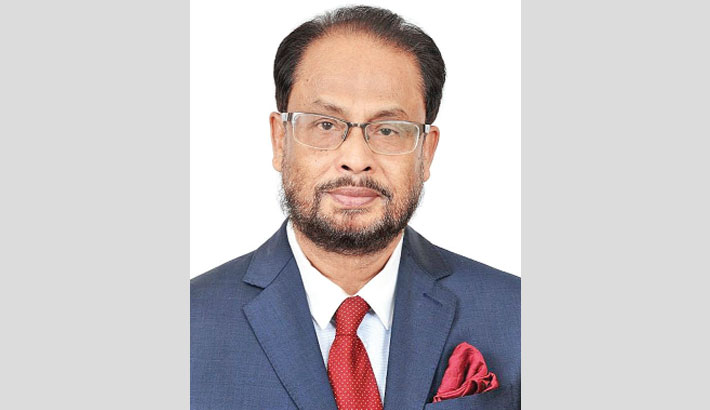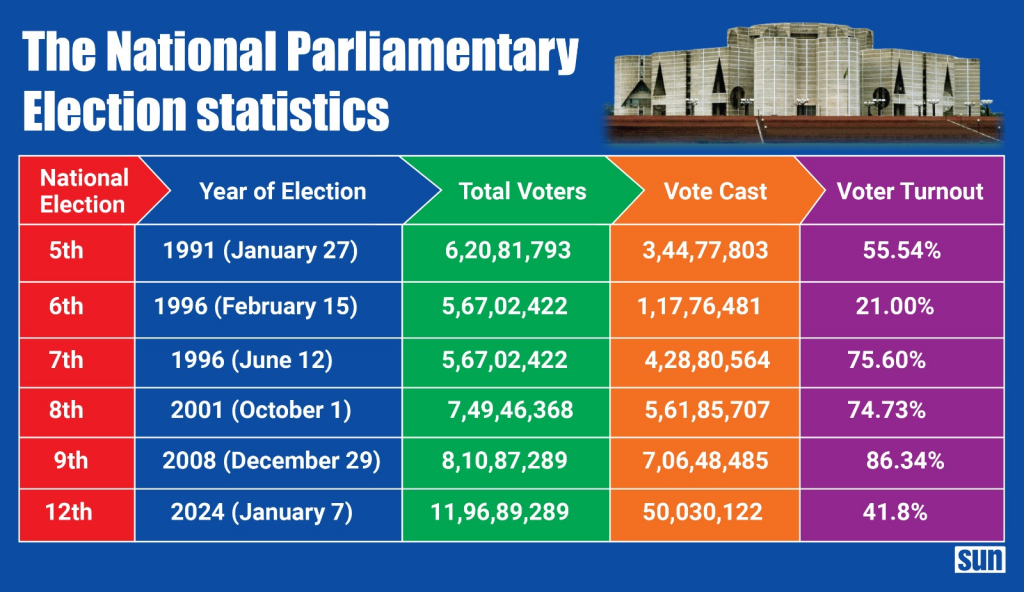
Opinion
How Was 12th National Parliamentary Election? (Part-I)
Ghulam Mohammed Ǫuader
Update: Thursday, 28 March, 2024 21:24
An election may be considered good or fair when the opinion of the people is reflected correctly in the outcome. It is possible only if the election is free, fair, participatory and held in an impartial environment. In case any of the above conditions are violated, the election does not reflect appropriately the verdict of the people. For that, it is not accepted as a good election. Constitution can be made and subsequently, laws can be formulated accordingly to give legality to any type of election. But those do not necessarily guarantee good election or acceptance of the same as such inside the country or internationally.
On the other hand, when most of the political parties participate, voting takes place in a free, fair and impartial environment with a good voter turnout, the election is considered participatory. In the 12th National Parliamentary Election, the Bangladesh Nationalist Party (BNP), an important political party, along with some alliance partners boycotted the election. The government and ruling party, Bangladesh Awami League (AL) decided to go ahead with the election as per the declared schedule despite the boycott. The question is whether the election could be termed participatory when one major political party along with a few alliance partners is not participating. The government’s version was that the presence of a good number of voters would make the election participatory.
It has been observed in Bangladesh that in case all important political parties, especially any of the two major political parties, AL and BNP, do not participate, voters turn out becomes insignificant. The choices come down and there exists a lesser scope of competition which could be the reason for lower voter turnout.
Can the 12th NPE be considered participatory?
Voter participation rate during the 7th NPE held on June 12, 1996, was 75.60%; during the 8th NPE held on October 1, 2001 it was74.73%; and during the 9th NPE held on December 29, 2008 it was 86.38%. Those elections were considered to be fair and were accepted as such, locally and internationally. In the context of these numbers, an election with a voter participation rate of 41.80% cannot be deemed acceptable as an inclusive and participatory election.

The Minister of Foreign Affairs, Hasan Mahmud, made some comments at Parliament regarding the latest election. He brought forward some voter participation data from other countries, where voter turnout was lower than what was in the 12th parliamentary elections. By that, he attempted to justify that 41.8% voter turnout was good enough to make the election a participatory one.
During National Elections in the United States of America (USA), usually 25-30% of voters cast their votes. In their opinion, this seemingly small number of votes still reflects peoples’ choices adequately.
In contrast to this, the voter participation rate is almost 100% in Australia. This is because, in an Australian context, their government system strongly believes that almost 100% of their population needs to vote. Only then, the election will be deemed fair, and the people’s voting choices will be appropriately reflected in the elections. That is why voting is made mandatory by law there.
This clearly shows that voter participation rates must be understood contextually, based on the specificities of each country, its government system and its people. In the case of Bangladesh, the average voter turnout rates were much higher (compared to 41.8%) in the case of all the elections considered as good and were accepted as such both nationally and internationally. For that, the logic forwarded by the Minister of Foreign Affairs cannot be accepted.
Did the polling centres have sufficient capacity to allow participation of more than five crore voters (41.8%)?
Let us analyse now the state of preparations and the circumstances at the polling centres during the last election.
- The total number of voters for the election was 11,16,89,209.
- According to the data from the election commission, votes were cast by only 5,00,30,122 voters (41.80%).
- The total number of voting booths was 2,61,568.
- Every booth was open for the stipulated 8 hours, and within this time an average of 191 people cast their votes at each booth.
- That means, 24 votes were cast every hour at any given voting booth. Per that calculation, each voter got 2 minutes and 30 seconds to cast their vote.
Casting each vote takes about 2.5 to 3 minutes. So, from a mathematical point of view, it is possible to achieve a casting rate of 41.8%. However, this would mean that every voting booth across the country had to be simultaneously and continuously operational and in action, with voters coming in, voting and leaving, without any margin for delays or confusion. To maintain this average, in some areas, voters would have had to remain waiting to cast their votes, way after the specified 8 hours. Point to be mentioned, this is allowed per the election rules, to keep the polling centres operational beyond the original eight hours to allow the awaiting voters to cast their vote.
The events that should have been observed justify the above.
- In front of every polling centre and every booth, there should have been a long queue of voters present almost consistently throughout the specified 8 hours of operation.
- In several polling centres, voters waiting inside the cordoned area should have continued to cast their votes after the specified hours.
Not a single observer has claimed that they have seen the above taking place in any one of the polling centres of the country.
Many eyewitnesses have illustrated that, on average, they have not seen more than 3 to 6 voters per hour, in any polling centres or polling booths. In a very few areas, an average of 12 votes were cast per hour. In most areas, voters were not able to cast their votes after a certain time. Allegedly, polling centres were seized, and false votes were cast.
So, it can be concluded that the claim of 41.8% votes being cast is not realistic. Rather it seems more likely around 5 to 10% of voters have participated in the process. According to spectators, in very few areas, 20% of votes may have been cast. A significant number of conscious people think that a lot less than 41.8% of voters have had the chance to cast their votes.
Considering the above, the 12th National Parliamentary Election may not be considered participatory or inclusive.
How free, fair and impartial was the election in different constituencies?
The voter turnout was far less than the declared figure as was perceived and was shown with reasons earlier. Naturally, the question arises of how the average of 41.8% voter turnout could be reached. The only possible answer could be that a significant number of ballots were stuffed in favour of a certain candidate. Another scenario might be, rather than counting the votes, the concerned authorities have fabricated and declared the results according to their own choice. We can reasonably argue that despite not being cast by voters, a significant number of votes somehow made their way into the published results. The winning candidate was favoured by vote rigging.
Let us now analyse the situation in different constituencies during the election. The observations are logical perceptions, based on views and documents provided by Jatiyo Party candidates, their workers, supporters and voters at large.
A free, fair and impartial election environment was seen in a handful of constituencies. It could be as per the desire of the ruling party/government. The elections in these constituencies were almost uncontested. The ruling party did not put any candidate.
An alternately heavyweight candidate from the ruling party was the only participant. The voter turnout in these areas was not satisfactory by any standard. Thus, even if this election can be claimed as free, fair and impartial, it was not a participatory or inclusive election.
At a larger number of constituencies, the election was held as what can be called a “Free Style” election. In these areas, the candidates were not bound to abide by any of the Election rules and regulations. Huge money and muscle power were used freely. None of the Election rules and regulations was upheld in these areas. Candidates tried to win by any means necessary and have successfully done so. Awami League workers and leaders acted as mercenaries and worked for candidates who provided better facilities.
These constituencies usually had a ruling party nominated candidate, a ruling party candidate as independent and in some cases Jatiyo party, other party or other independent candidates. In some of these constituencies, there was no ruling party candidate but the ruling party candidate as independent contested.
As mentioned earlier, a smaller presence of voters and the availability of unused ballot papers could make it possible to tip the results in favour of a certain candidate. It is also evident that the election authorities too had an impulse to demonstrate higher voter presence. This has presented an opportunity to use the blank ballot papers by the people in charge.
According to many sources, huge money, muscle power and connection with the authorities have made it easy for the ruling party nominated candidates or their nominated independent candidates to take advantage of these unused blank ballot papers.
In a few cases, other independent candidates have also taken advantage of this opportunity. This was a major factor in obtaining favourable election results.
Allegedly, all the people related to the election process, including local administration, law enforcement and others, were persuaded or influenced in some way to cooperate in this act of result manipulation.
In the case of remaining constituencies, the public at large believe that no matter what was there in the election, the results were predetermined. It is a widely accepted perception that a good number of unused ballot papers were stuffed or result sheets were fabricated.
As a result, none of the above-mentioned elections are deemed to be free, fair and neutral.
The allegations presented here have not been confirmed by any judiciary, hence elections are not considered illegal. Nevertheless, most of the population do not believe the Election was a good one that appropriately reflected the opinion of the people at large.
Contemporary rules and regulations were massively violated. It is alleged that the authorities in charge have tried to avoid responsibility. In some cases, it is also alleged, the authorities themselves got involved in the manipulation.
To conduct a morally acceptable election in future, one that truly reflects the opinion of the people; a set of rules, laws and even the Constitution may have to be modified and amended.
The writer is the Chairman of Jatiya Party and Leader of Opposition in Parliament
News Link: https://www.daily-sun.com/post/741492

